 Sandy Berger The view out of Sandy Berger’s window.
Sandy Berger The view out of Sandy Berger’s window.I’m not averse to bacon. I used to make it, on very rare occasions. But ever since the International House of Putrid Odors opened and its ventilation fans began pumping out the smell of recycled bacon through my bedroom windows, a mere whiff of it is enough to make me ill.
Last August, before IHOP opened on East 14th Street, two gigantic air conditioners suddenly appeared on its second floor roof (they must have been crane lifted). At night, when it used to be pretty quiet, they sounded like 100 antiquated air conditioners running simultaneously.
It took several 311 complaints before a Department of Environmental Protection inspector found them in violation of the law. The inspector told me he knew he’d be back once the restaurant opened: he predicted there would be odor complaints, and he was so right. Read more…
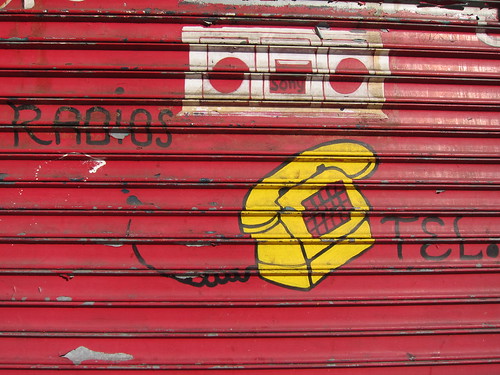 Scott Lynch
Scott Lynch
The conclusion of Brendan Bernhard’s quest to address one of the banes of New York City apartment living: a neighbor’s noisy radio.
The landing was a long, very narrow rectangle of peeling linoleum, about four feet wide, with a continuation of the staircase in the middle of it leading up to the roof, as well as a window that let in some much-needed sunshine. The radio was coming from my right. Two grim apartment doors faced each other at one end of the corridor, painted that soul-destroying brown so cherished by New York landlords. It was obvious which apartment the radio was in and I started banging on the door right away. No answer. I banged some more. Nothing. So I tried the door opposite, hoping to find a sympathetic neighbor trembling on the brink of a nervous breakdown. Again nothing. Was everyone dead?
Read more…
 Philip Kalantzis Cope
Philip Kalantzis CopeIt had been going on for months. At 6 a.m., every morning without fail, the Day of Rest included, we would be awoken by the morning’s news as presented by WABC at a volume that would stun a rock star. News, weather, traffic, sports, commercials. News, weather, traffic, sports, commercials. News, weather, traffic, sports, commercials…. And then, after about an hour, a silence so deep it was like being parachuted into a desert. The radio had been turned off. After that, it would return (at the same blistering volume) sporadically throughout the day.
Our bedroom, which is small, gives out onto an air shaft. My wife and I usually sleep with the window open, even if just a crack, to let in some air. It’s the original tenement window, and the glass is about as noise-resistant as a few sheets of newspaper. But even if we had one of those titanically thick, gas-filled windows they use in airport hotels so conveniently located they’re practically on the runway, nothing would have been enough to keep out the din of that radio.
But where was it coming from? It took a long time to discover. Our apartment overlooks a dank courtyard, and noise bounces around maddeningly. Once, in the middle of the night, I heard a woman’s voice — one of those brassy New York voices you hear less and less frequently — call out, I know you’re looking at me, you pervert! But there was no clue to what building she was in, let alone the location of her hapless peeping tom.
Read more…
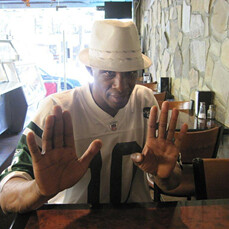 Brendan BernhardKevin.
Brendan BernhardKevin.We met because he needed money, and I happened to be standing on Avenue A in bright, windy sunshine looking like someone who had more of it than he did. Not that he looked poor exactly. He was wearing a nifty white hat, a clean New York Jets shirt, and blue jeans. He was a tall, good-looking black man with a friendly smile and what appeared to be a positive attitude. Before handing over a buck, I asked him why he couldn’t find a job.
“Five felonies” was his crisp reply. It sounded like a movie title. One of the five, he said, involved a cut throat, but it was an “accident.” He’d served time (several times), had stayed out of jail since 2005, and had no plans on returning. We talked about this and that for a minute or so and then parted ways.
An hour later I ran into him again. He was walking down St. Marks Place. He looked cheerful and greeted me like a long lost friend. I’d already told him I was a journalist and so we decided to stop at a kebab house on First Avenue for a brief interview. Of course there was a price: We settled on $10. Since I refused to pay extra for food, he purchased a minute salad from the self-service counter, which left him with $8.81.
I quickly jotted down some basics. Name: Kevin. Age: 40. Birthplace: Yonkers. Mother a cleaning lady, father an alcoholic. It turned out Kevin did have a job of sorts: Selling roses on the street, mostly in SoHo. But since he also had five felonies on his record, and was panhandling, I cut to the chase.
“What’s the problem?” I asked.
“Women, drugs, and alcohol.”
“What’s your problem with women?”
“I never had a problem with women. I make a problem. I don’t trust ‘em.”
Read more…
 Michelle Rick
Michelle RickYou notice them everywhere in Manhattan, but perhaps particularly in a slightly out-of-the-way neighborhood such as the East Village — middle-aged or older New Yorkers who look as if they have remained in the city that doesn’t sleep way past the limits of insomnia or common sense.
They seem a little lost in this International House of Cupcakes, among i-Stoned youth, galvanized immigrants, packed bars, and cafés where the music is always played at a volume whose message might as well be posted on a notice board outside — Adults Permitted, But Youth Preferred.
Aging is a delicate, unrewarding business at best, and some people — as a result of genes, outlook, resolution, and money — manage it better than others. To judge by the relative lack of oldsters in the East Village (anyone over 40 is a rarity on the streets after 9 p.m., and most of those are either homeless, comatose, or possibly dead), it’s obvious that this is one of the more trying places in which to grow old. Those who hang on must also confront the irony of living in an era in which they are constantly scolded that it is within their power to remain “young,” while being made to feel ancient almost all the time.
Read more…
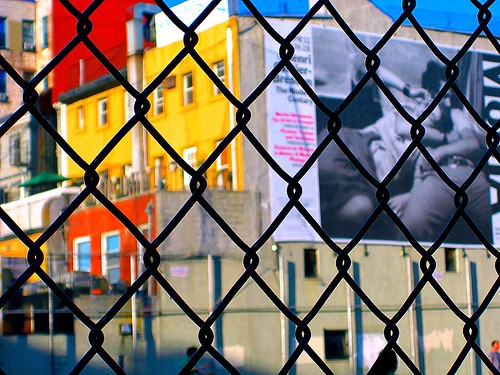 Michelle Rick
Michelle RickCities are unforgiving places, and New York perhaps the least forgiving of all.
One of its less attractive traits has always been its self-mythologizing triumphalism and I ♥ NY campaigns, a localized form of the nationalism it derides in the rest of the country. “If I can make it there, I’ll make it anywhere,” Frank Sinatra sang in what has become Manhattan’s unofficial national anthem and New Year’s rallying cry. It’s a sentiment to which countless scrambling citizens still subscribe. If they can just work hard enough, be ingenious and ruthless enough, they too will be “king of the hill / Top of the heap,” because this is the place. Or so we like to think.
Is it, though? Just over a century ago, C.P. Cavafy (1863-1933), an enduringly popular Greek poet who lived in Alexandria, Egypt, wrote a 16-line poem called “The City” which immortalizes a peculiarly urban dilemma whose outlines disenchanted New Yorkers will readily recognize. Those who have just moved here should read the poem, memorize it, print it out, and stick it on the fridge door.
Read more…
 Mario Ramirez
Mario RamirezThe bicycle is such a decorous, ingenious, quiet machine, it’s a shame it has become a politicized one as well. But when you see somebody on a bike with a placard attached to it which reads A QUIET PROTEST AGAINST OIL, you know Politicization has arrived. (On First Avenue, in this case.)
Beautiful and ingenious as the bicycle may be, the human body is even more beautiful and ingenious, at least until the age of 60, and especially below the age of 30. And let’s not forget one important thing. As a pedestrian, I also fall into the category of partaking in A QUIET PROTEST AGAINST OIL, unless I’m in a cab. I just don’t have a sign, or a T-shirt, with which to make this fact plain. But I’m going to get one. It’s going to be a quiet protest against other, equally quiet protests.
Read more…
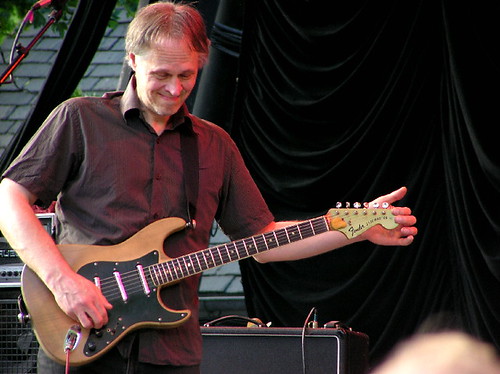 Heartonastick Tom Verlaine performing at Central Park Summerstage, 2007.
Heartonastick Tom Verlaine performing at Central Park Summerstage, 2007.There are certain artists one wishes one could outgrow. They belong to one’s youth, after all, and perhaps they should remain there, along with all the other youthful things one is relieved to have outgrown. But for me, the music of the CBGB’s-era band Television, and in particular its singer and songwriter, Tom Verlaine, is one of those youthful enthusiasms which (so far, anyway) threads its way through my life with embarrassing persistence. Occasionally it disappears for long periods while other, more novel interests take hold, but then, like mosquitoes in Spring, back it comes, nipping at the senses as tenaciously as always, only in this case the result is intense pleasure rather than irritation and blood marks.
Television was, or is — no one seems to be sure of its exact current status — the band best known for inaugurating the CBGB’s scene in the mid-1970’s; for having to this day a small but ferociously loyal group of devotees; and for having been eclipsed, at least in terms of popularity, by other bands of that era such as Talking Heads, Blondie, The Ramones, et al. Even by the monstrously egotistical standards set by most rock stars, they seemed weirdly indifferent to fame and record sales, but like the Velvet Underground their musical influence remains pervasive and lives on in a variety of formats which now include amateurishly filmed but invaluable concert clips put up on YouTube.
Read more…
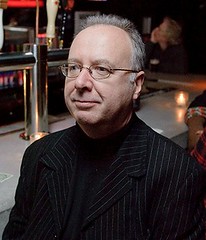 Kim Davis.
Kim Davis.It’s understandable, to me anyway, that East Village residents are concerned about NYU’s ambitious expansion plans and how they will affect the architecture and ambience of a treasured neighborhood. After all, it was the East Village which was landed with the enormous Founder’s Hall dormitory on East 12th Street, and although NYU might consider University Hall on East 14th Street part of the Union Square neighborhood, it supplies a steady stream of student revelers to the avenues running downtown from that location and into the heart of the East Village.
Even so, I read Rob Hollander’s post today on Save the Lower East Side with some puzzlement. “East Villagers ought to be alarmed by NYU’s decision not to build on its own campus,” he writes.
That’s something which might well give rise to concern, but as The Local recently reported – and even the The Greenwich Village Society for Historic Preservation agrees – that’s not the decision which has been made at all. As the preservation group put it, “NYU is insisting that they will move ahead with seeking permission to build on the adjacent non-landmarked supermarket site instead.” In other words, the university is at this time pressing ahead with its original core plan.
Nobody can deny that the East Village may have plenty to worry about further down the road if the core plan does fail, but that hasn’t yet happened. So far, we are still chasing shadows. One irony which Rob Hollander’s post does highlight is that success in opposing the university’s plans for the Washington Square campus is indeed likely to have repercussions for other neighborhoods.
Kim Davis is the community editor of The Local East Village.
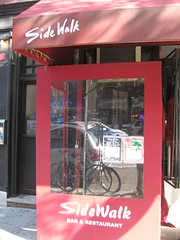 Kim Davis Sidewalk Café, 94 Avenue A.
Kim Davis Sidewalk Café, 94 Avenue A.Sidewalk Café, nestled on the northeast corner of Avenue A and Sixth Street, looks like an unassuming bar with the usual dingy decor, cheap happy hour, and constant huddle of smokers at the door. But the backroom boasts a different sort of history, one filled with battered guitars, risky performances, and a tidal wave of eccentric entertainers looking to pick up a fan or two.
This East Village staple, around since the late 1980s, has long been home to an almost overwhelming roster of young musicians. The Café boasts free live music every night of the week, as well as some comedy shows, but the cost is hidden in the two drink minimum (not a problem for most attendees).
Read more…
 Emily Anne Epstein New bike lanes in the East Village have brought new perils for cyclists.
Emily Anne Epstein New bike lanes in the East Village have brought new perils for cyclists.The paint and concrete have barely dried on the East Village’s new bicycle lanes, but already business owners and residents are concerned about new dangers for neighborhood cyclists. The new lanes on First and Second Avenue pose a range of potential hazards from open car doors to riders who go against the flow of traffic.
Christopher Feltman, co-manager of the Second Avenue bike shop NYC Velo, estimates that wrong-way bike traffic has increased at least fivefold since the lanes were installed this summer.
“As a rider, I think it’s been worse,” he says of safety on Second Avenue since the lanes were added. “Because they painted it green, a lot of people take that as ‘I can go both ways on it.’”
Read more…
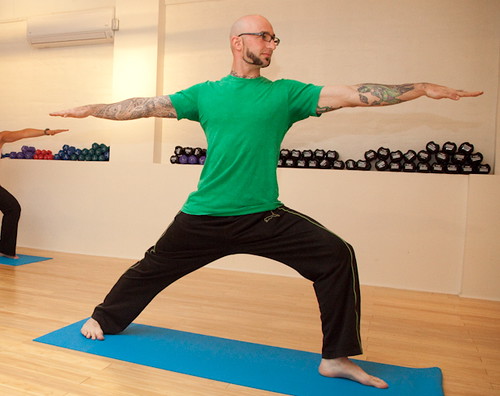 Courtesy Al Kavadlo The author strikes the Warrior II pose.
Courtesy Al Kavadlo The author strikes the Warrior II pose.Community contributor Al Kavadlo, a personal fitness trainer, offers his perspective on Yoga to the People.
I’ve done yoga on and off for nearly a decade and made my living as a
personal trainer in this neighborhood for almost as long. I’ve walked by
Yoga to the People countless times over the last several years, but never
attended a class until recently, when my curiosity, coupled with the
fact that I’d recently been neglecting my yoga practice, finally got me into the old pre-war walk-up to sweat it out.
The vibe inside was welcoming, and the instructor was friendly and
professional, yet there were some negative aspects to the experience. Most yoga studios that I’ve encountered in the city are typically crowded, but I’d never before seen this many people in one room.
Read more…
















